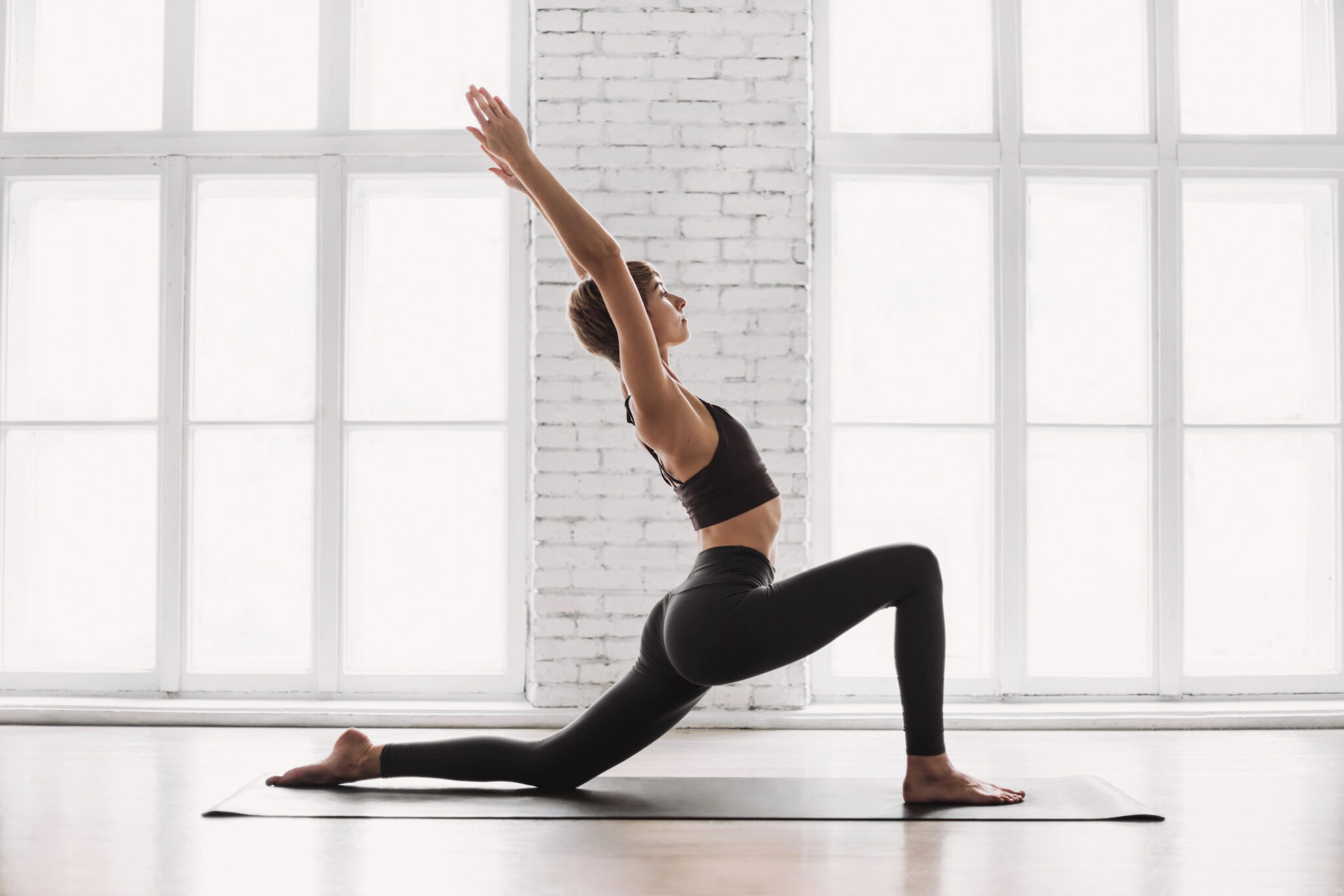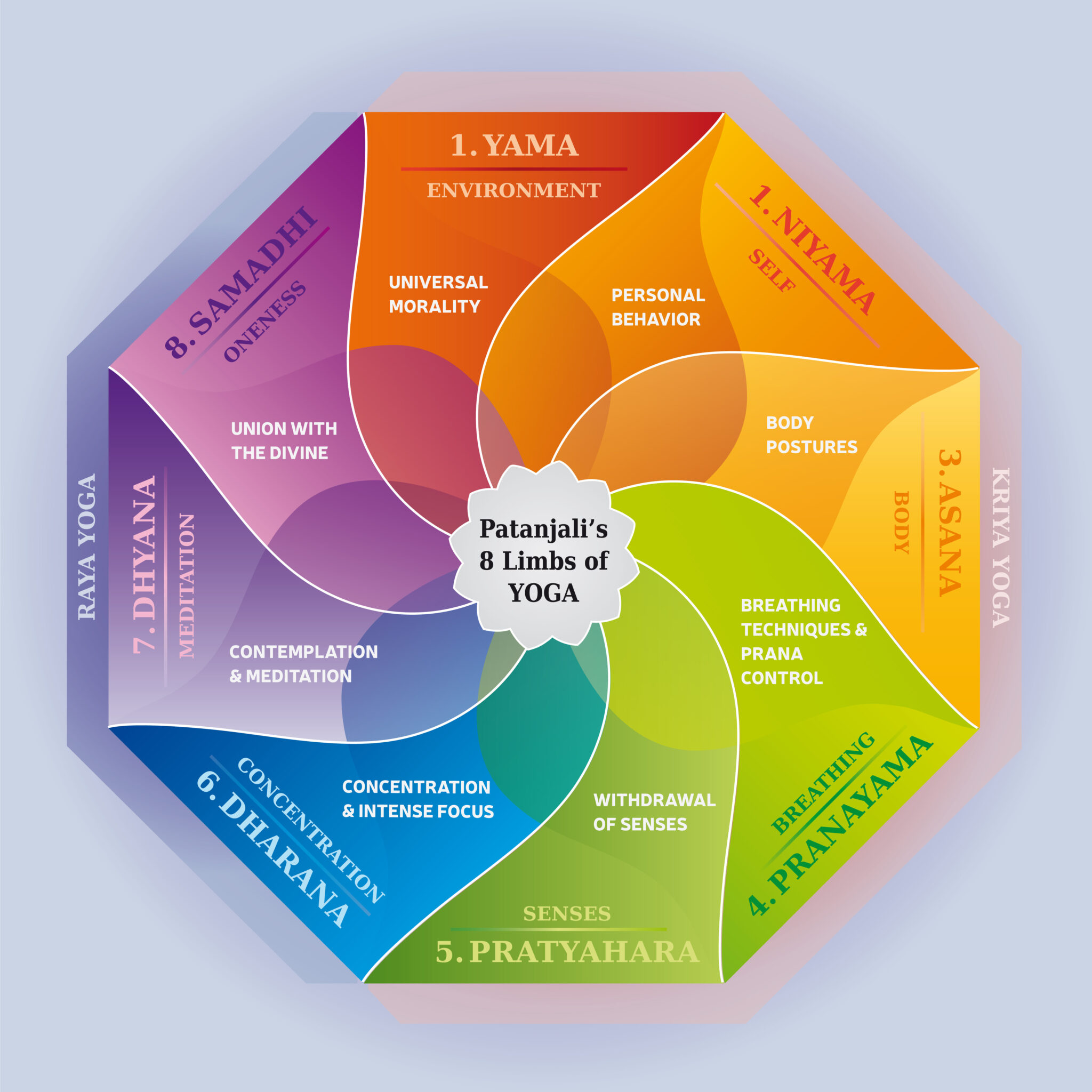Yoga


What is it?
Yoga is probably one of the terms with the most buzz in recent years. In fact, it can be the trendiest wellness term in our century. According to a national survey conducted by Yoga Journal and the Yoga Alliance, the number of people practicing yoga in the US grew more than 50% from 2012 to 2016. But what is it really about? Keep reading to get more educated on this fascinating practice.
In Sanskrit, Yoga means “union”. The Sanskrit root “Yuj” means “to join”, “to yoke” or “to unite”. As per Yogic scriptures, the practice of Yoga leads to the “union” of individual consciousness with that of the universal consciousness.
In a historical sense, yoga refers to the enormous body of spiritual teachings and techniques developed by the inhabitants of the Indian subcontinent over the last 5,000 years. While many assume that yoga is a homogeneous practice, it has thousands of schools, each one with a distinctive doctrine.
From the perspective of a beginning practitioner, the term yoga describes the goal of union sought through practice. One practices postures, breathing, and meditation to harmonize body and mind. From the perspective of an adept practitioner, yoga is a way of being accessible in each and every moment. In this light, yoga clears obstacles that prevent us from being who and what we truly are.
Regardless of doctrines, modalities, or levels, all yoga practices have one thing in common: keep life energy (prana) flowing at its optimal level. From this angle, we like categorizing yoga as a powerful energy practice, similarly to Qigong, despite the fact that its benefits span across body, mind, and spirit. Practiced correctly, yoga can purify and amplify your energy, which provides, in many cases, a framework for physical and spiritual health.
Core philosophy
Yoga is about joining our inner nature and our universal nature. The practice of yoga achieves this through two separate awakenings, the awakening of spiritual energy, which involves the purification of the subtle body, and the awakening and expansion of consciousness to the direct perception of truth.
Center to this is the concept of prana. Prana is an energy that exists throughout the human body, but when dormant, it is stored in sizable amounts near the base of the spine. Through yogic practices, especially breathing techniques called “pranayama”, this energy awakens and begins a gradual ascent through the body, towards the crown of the head.
This dynamic ascent of prana is called “kundalini” in Sanskrit. As the energy of kundalini rises through the body, it opens and purifies the energy hubs along the way. These hubs or centers are the “chakras” and we have seven of them. Gradually, the whole body becomes radiant, bringing deep a deep sense of joy and fulfillment.
The journey of yoga is only partially completed by the process of kundalini and the purification of the body. With the development of inner silence through meditation, we learn to experience peace. This is the awakening to our higher Self, sometimes called the “realization of truth” (Dharma). At this point, the boundaries set by the mind fall apart and we see things pure and just as they are.
The eight limbs of yoga
In order to understand the core of yoga, we need to understand the Yoga Sutra, widely regarded as the authoritative text on yoga. The Yoga Sutra is a collection of aphorisms, outlining the eight limbs of yoga. These sutras (or “threads”) of wisdom, authored by the ancient Patanjali, offer guidelines for living a meaningful and purposeful life. These eight limbs of Yoga are necessary to attain “Moksha”, or the release from the karmic cycle of rebirth. These limbs are the following:
- Yama (universal moral codes)
- Niyama (self-purification by discipline)
- Asana (postures)
- Pranayama (rhythmic control of breath)
- Pratyahara (withdrawing of mind from senses)
- Dharana (concentration)
- Dhayana (deep meditation)
- Samadhi (union with the object of meditation)
Yama and Niyama
Asanas are the mental picture for yoga practices nowadays, even though Patanjali saw it as one component of a much bigger system. Under the commandments of Yama and Niyama, he put forth five principles to guide the way of living and five inner observances to lead a peaceful life. These include:
- Ahimsa: non-violence. this requires being free from fear and anger.
- Satya: truthfulness in thought, word and deed.
- Asteya: not stealing.
- Brachmacharya: life of celibacy and self-restraint. In modern times, it is the art of consistency, sustaining energy, and not depleting vitality.
- Aparigraha: which means “not grasping things”. A yogic maxim says “all the things of the world are yours to use, but not to own”.
- Shoucha: purifying your mind and body. It consists of asanas, pranayamas, bhakti (devotion), food and place of practice.
- Santosha: contentment.
- Tapas: achieving a definite goal in life – leading a disciplined life.
- Savdhyaya: education or daily ready.
- Isvara pranidhana: dedication of one’s actions and will to God.
More modern principles
Yoga has evolved over time and it encompasses now newer principles that form the base of its practices. These four basic principles underline the holistic approach of Yoga in modern times.
- 1st principle: The human body is a holistic entity of various interdependent dimensions, inseparable from one another. The health or illness of any one dimension affects the other dimensions.
- 2nd principle: Individuals and their needs are unique and therefore must be approached in a way that acknowledges this individuality and their practice must be tailored accordingly.
- 3rd principle: The student is his or her own healer. Yoga engages the student in the healing process; by playing an active role in their journey toward health.
- 4th principle: The quality and state of an individual’s mind are crucial to healing.
A more practical and modern perspective on Yoga’s current philosophy is as follows:
- Proper relaxation: by releasing the tension in the muscles and putting the whole body at rest, you revitalize your nervous system and achieve inner peace.
- Proper exercise: achieved through asanas, systematically working all parts of your body. The execution of asanas is beneficial to the body, mind, energy, and spirit.
- Proper breathing: breathing fully and rhythmically, making use of all the parts of your lungs to increase your oxygen intake. Proper breathing should be deep, slow, and rhythmical.
- Optimal diet: what you eat extremely affects your mind. Improper diet results in mental inefficiency and blocks spiritual awareness. A proper diet is one that nourishes both the mind and the body.
- Positive thinking and meditation: the way we think highly affects our way of life. Positive thinking and meditation help your your mind under perfect control.
This more modern perspective emphasizes the importance of exercise, breathing, and meditation, three of the main pillars of modern Yoga.
Popular yoga styles
There are different types of yoga, including Bhakti Yoga, Jnana Yoga, Karma Yoga, Raja Yoga and Hatha Yoga. They can be seen as different routes towards the same goal. For example Karma Yoga’s encourages act of service as a means to enlightenment, where Hatha Yoga encourages mindful body positioning and breathing. The mainstream yoga available today is predominantly based on Hatha Yoga and some of the most popular variations include:
- Hatha: “Hatha” is the term for any type of yoga that involves proper positioning and breathing. Hatha Yoga is a slower, softer style of yoga that is perfect for entry-level practitioners.
- Vinyasa: “Vinyasa” means “orderly manner of arranging”. The positions of the body and the breaths must follow a form and sequence. Unlike Hatha Yoga, Vinyasa Yoga is a dynamic activity where a pose won’t be held long and may even be set to the rhythm of music like a dance.
- Iyengar: This practice pays closer attention to alignments and anatomy. Precision forms will be the path to excellence and postures will be maintained for much longer. Iyengar is an advanced yogic practice, but still accessible to amateurs.
- Ashtanga: It involves the execution of a series of postures that boost the body’s internal heating elements. By the induced perspiration increased heart rate and synchronized breathing exercises, the body is purified of toxins.
- Hot: Aimed at increasing the flexibility in muscles and the metabolism with a series of yoga postures. During the Vinyasa style routine, the heat can help the body loosen up and make muscles seem more limber.
- Kundalini: Aimed at awakening the Prana or Shakti. It achieves this by including mantra chanting, yoga, breathing practices, and meditation. Kundalini Yoga requires guidance. The breathing exercises and meditation might be the toughest aspects of the practice, but tapping into inner reserves of energy is certainly worthwhile.
- Yin: Much like Hatha Yoga, the breathing is slow and deep. Postures are held for up to five minutes at a time. The time in these postures is for meditation and reflection on the switch between Yin and Yang.
History
It is not farfetched to say that the way we understand yoga now would be completely unrecognizable to the original Yogis. Some might attribute this to the oversimplification of ancient topics to make them more palatable to a technologically advanced civilization.
However, yoga has evolved so much over time that flexibility is the very nature of yoga. We’ll take a brief look at the four main periods which have been most influential to the creation and development of modern yoga.
Vedic Period
This era relates to when the Vedas, four ancient scriptures (Rigveda, Yajurveda, Samaveda, and Atharvaveda) were created. The Vedas themselves are the holy writings of Brahmanism. It’s this collection of hymns that contain the oldest known teachings about yoga available. Teachings in the Vedas are called Vedic yoga and they are characterized by ceremonies and rituals that encourage a broadening of the mind to surpass its limitations.
During this period, people relied heavily on “rishis” a Vedic term used to describe an enlightened person. These rishis would act as guides, sages who could instruct people on how to correctly follow the teachings outlined in the Vedas.
While asana and pranayama are important aspects of yoga, they rarely amount to more than a small fraction of content in all the Vedas, Upanishads, and Sutras which discuss Yoga in its entirety. Yoga is more about the cultivation of an important connection with the self, world, and universe as a whole.
Pre-Classic Period
Following the Vedic period came the pre-classical period. In this era, we witness the creation of the Upanishads, a collection of 200 Vedic texts. Many believe that both the Vedas and Upanishads form the basis of religious concepts for Hinduism, Buddhism, and Jainism.
The pre-classical period culminated in the creation of the 700-verse Bhagavad Gita, credited as the oldest known yoga scripture and the most famous of Hindu texts. Another important way the Upanishads altered the practices of the Vedic Periods was the practice of sacrifice. Animal sacrifice from the Vedic times was common during the Pre-Classical period and manifested as the sacrifice of the self or the ego.
Classical Period
Patanjali’s Yoga Sutras are the very foundation of classic yoga. In the Sutras, Patanjali offers guidance to help the reader create peace and achieve fulfillment. A small but important note to make at this stage is that there were several authors by the name of Patanjali and work continues to determine who is the actual author of the Yoga Sutras. Regardless of authorship, it’s hard to refute the importance and subsequent popularity of the Yoga Sutras of Patanjali.
Another defining factor of the classical yoga period is the emergence of the eight limbs of yoga. If you are currently studying your yoga teacher qualification or have recently completed one, this will already be very familiar to you. Patanjali instructions touch on a wide range of other topics of yoga practice. The aphorisms Patanjali used to convey these philosophies and teachings from the foundations for subsequent yoga practices and literature.
Post-Classical Yoga
Yoga came to the West in the early 19th century and predictably, many of its Eastern teachings and philosophies steadily became Westernized. It was this period as well that saw many teachers and gurus travel to the West.
Swami Sivananda was an instrumental figure in the rise of modern Yogic Culture and was responsible for the establishment of many Yoga Schools in Europe and the US. Sivananda codified teacher training and developed a yogic system, based on the Five Principles of Yoga. This was much like writing a prescription for good spiritual, physical, and mental health in the environments he personally observed.
Modern Yoga
The practice of yoga today is the product of many millennia of evolution and adaptation to the need of the times. Yoga and its various practices, techniques, and traditions are subject to change as needed. Yet, the underlying movements, goals, and ideas remain much the same as they have since the Stone Age.
In some respects, modern yoga, the form practiced in studios, gyms, and homes all over the world can be seen as just as complex as the lineages that have come before it. Many current styles are based on hatha yoga, which was initially introduced in the yoga sutras.
Benefits and uses
The benefits that yoga can bring to your day-to-day life at both a mental and physical level are many and varied. In case you needed a few reasons as to why you should incorporate this practice into your life, the following summary could finally convince you.
Yoga not only helps you balance your body and mind but also can help you get the state of inner peace you have been seeking for so long. The benefits of yoga at both a mental and physical level are many and very diverse. You will begin to notice them from the very first session and if you embrace the underlying philosophy of it, it can have lasting positive effects on your life.
Reduces stress
Yoga helps minimize issues that are common for many of us, like stress and anxiety, commonly derived from our busy lifestyle. It reduces our level of cortisol, the hormone that our body releases when we are under stress.
Clears your mind
Only 15 minutes of yoga a day is enough to achieve favorable changes in the brain’s biochemical activity. As a result, it enhances your ability to concentrate and learn, while simultaneously benefiting your memory.
Improves flexibility
Practicing yoga is about, among other things, stretching and toning the muscles. This is why it is helpful in obtaining a more upright posture and the resulting benefits. For this reason, it is especially ideal for those who suffer from back problems, and in general, for anyone who for work reasons is sitting many hours a day in front of a computer.
Increases energy levels
At an internal level, yoga activates the mechanisms the release dopamine, “the hormone of happiness.” In fact, dopamine is closely related to pleasant sensations, which is why yoga ends up “hooking” most of the people who try it and have enough patience to learn to enjoy the practice.
Reduces the risk of illness
The immune system is another great beneficiary when practicing any type of yoga. The different poses or asanas that are a part of the practice, along with the breathing exercises that accompany them, put the immune system to work. This contributes to its strengthening, and as a result, one’s chances of getting sick decrease.
Who practices it
Teaching yoga goes far beyond creating sequences and instructing postures. The yoga instructor’s role is to create a safe and nurturing environment and guide students through mindful practices to quiet the mind and connect to ourselves. In addition to understanding the anatomy of movement and intricacies of yoga postures, a yoga teacher must also know and embody yoga’s philosophy.
Therefore, the role of yoga instructors is twofold. On a superficial level, the instructor must understand the human body to guide movements safely. On a deeper level, the instructor inspires students to live a mindful life and creates subtle transformations in thought patterns.
Many people, in fact, become yoga instructors even if teaching yoga is not their career goal. Oftentimes, train to become a yoga instructor to deepen their knowledge or improve their practice. Aspiring instructors explore topics such as the history and philosophy of yoga, yoga anatomy, and detailed alignments. Practices such as pranayama and meditation, two significant yoga pillars that are mostly absent from yoga classes, are often prominent in yoga teacher training.
To respond to the increasing demand for yoga teachers, yoga schools started appearing worldwide, and programs were developed to mass-produce yoga instructors. In the 1900s, a group of instructors began to discuss the need to establish a national standard for yoga instructor training, and from this, the Yoga Alliance was born.
Becoming an instructor
Today, the typical path to becoming an instructor is to follow a 200 or 500-hour teacher training at a reputable school. A large number of teacher training certifications are registered with the Yoga Alliance or other well-known associations worldwide, such as the British Wheel of Yoga or the Yoga Alliance Professional. While having credentials from an accredited school is a strong plus, some great instructors come from unaccredited schools. Yoga teachers can get hired based on their skills, more so than the school they are coming from.
Yoga is an unregulated practice and therefore, there are no specific legal requirements attached to it. And despite the popularity of the practice, many yoga instructors struggle to succeed financially. In addition to teachers, they are really entrepreneurs. Depending on their employer and schedules, instructors may work daytime, evening, night, weekend, or holiday shifts.
What to expect
If you always wanted to join a yoga class but are too nervous to try, read on! And even if you’re a connoisseur, the following points can help get the most out of your practice.
Do your research
It is worth doing some research on the teacher and the style of yoga. Doing so will help you make the best choice best on any possible expected physical or spiritual outcome.
You will not nail all the poses
You can only push your body so far, and yoga works muscles that you may not have been even aware of before (especially in your first class). If you’re unsure about how to do a pose, pay attention to the instructor or your neighbor.
Talk to your instructor
Your instructor’s purpose is to guide and help you. They are the experts. Because of this, don’t be worried about looking silly or feeling bad for now knowing what to do.
Your instructor will adjust if you’re comfortable with it
Your instructor will likely ask the class if anyone has reservations about being adjusted into positions. If you don’t mind being touched, let them adjust you so they can physically move you into the correct pose. It makes a huge difference.
Follow the class
The instructor will guide the students through the different moves, visualizations, and breathing exercises. Listen carefully while you also put mindfulness in the moment.
Breathing is crucial
Don’t underestimate the importance of breathing. Yoga requires a methodical and mindful way of breathing called pranayama. Often, you’ll hold your breath for several seconds or do a long exhale. This all serves a purpose.
Not all classes are equal
Not only different styles are quite different from each other, but also within a style, classes can vary a lot by instructor. And even with an instructor, your body will react differently in each class. Therefore, keep this in mind and just do the best you can every time.
Rever each other
You will hear “Namaste” before and after the class. It means “I bow to you” and it is a sign of respect and gratitude. It creates a bond between you, your instructor, and your fellow classmates. Typically, Namaste is accompanied by putting your palms together at your heart and bowing.
You can always relax in child’s pose
Child’s pose is commonly used to relax while taking a break. You kneel on the mat, knees separated and toes together, with your arms laid out behind you. If you ever feel uncomfortable, tired, or just want to relax in the middle of class, this is the pose to go to. No one will judge you for taking a break.
Ohming
Many yoga classes start by chanting Om – but if it’s a longer chant it will usually be a call and response. If you don’t want to join, don’t, but chanting is a great way of uniting the energy of the group and you might enjoy it.
Leave your ego at the door
Remember that yoga is not a competitive sport, so you should leave your self-criticism behind. Similarly, don’t refuse the aid of props (blocks, belts, blankets, etc.) just because it makes you “look like a beginner”.
Don’t skip Savasana
Savasana – the relaxation part of the class – can be one of the most challenging parts of the class for beginner and experienced yogis alike but it is also one of the most essential. Savasana is where we fully absorb the benefits of the postures, it can act as a “reset” button, calming the central system and bringing the breath back to normal. It’s the part of the practice where we can truly allow ourselves to simply be.
You will need hydration
Yoga can be strenuous and you will need hydration. Drink plenty of water before you hit the mat, and take a water bottle with you to class. You can take sips of water between poses. Many people keep water bottles at the front of their mat so they can drink during class.
Yoga is always there
Whether you love your first yoga class or are unsure if you want to do yoga again, it is always there. The yoga community is an amazing one and will always welcome you with open arms and a “Namaste”.
Interesting facts
Yoga is in our everyday lives one way or another. Here are some interesting facts about this ancient and far-reaching practice:
- Yoga is the most commonly used complementary health approach in the United States.
- Male yoga practitioners are known as ‘yogis’, female practitioners are known as ‘yoginis’.
- In 2016 there were over 52,000 registered yoga teachers.
- There are more than 100 styles of yoga.
- Yoga has 84 basic asanas or poses.
- Research has shown that practicing yoga can delay aging.
- Yoga classes used to be just for men. Women were not invited until 1937.
- Prisoners in India can reduce their sentences by getting top marks in a yoga test.
- Regular yoga sessions could impact a woman’s sex life with exciting results. It shows marked improvements in desire, arousal, orgasm, and general satisfaction.
Check out the TED video below to see more:
Closing statement
The purpose of yoga is to create harmony in the physical, mental, energetic, psychological, and spiritual aspects of the human being. For many, yoga can be the medicine for nearly every problem given the breadth of facets it impacts.
Moreover, yoga is not just a one-day practice, but a lifelong commitment. In fact, the more you practice yoga, the more you benefit. And ultimately, if you stick to it, it can become a very solid foundation to live on and can contribute to realizing your highest potential.
Newsletter
Sign up for emails to get the scoop on our latest articles, new developments and more.

